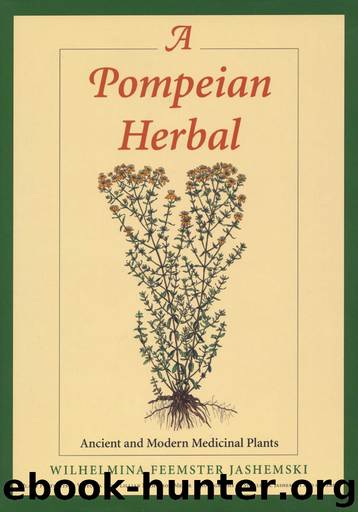A Pompeian Herbal by Wilhelmina Feemster Jashemski

Author:Wilhelmina Feemster Jashemski [Jashemski, Wilhelmina Feemster]
Language: eng
Format: epub
Publisher: University of Texas Press
Published: 1999-06-18T04:00:00+00:00
16
Foeniculum vulgare Miller
ENGLISH, FENNEL
Italian, finocchio, finocchietto
Fennel, an aromatic perennial, three to four meters in height, with fine, feathery leaves and umbels of small, intense yellow flowers, grows luxuriously in excavated areas at Pompeii. Women living in the excavations recommended it, boiled in water, for digestive problems. Dry fennel seeds taken in the mouth after eating were recommended for stomach ailments. When the plant is boiled in water along with Bermuda grass, knotgrass, and tender blackberry tips, and sweetened, the resulting liquid can be drunk cold for digestive problems, or hot for colds. A mixture of fennel seeds boiled with laurel leaves and chestnuts is used for digestive problems.
Pliny gives many medicinal uses of fennel (feniculum), but he is most interested in it as an eye medicine.
Fennel has been made famous . . . by serpents, which taste it to cast off their old skin and with its juice improve their eyesight. Consequently it has been inferred that by fennel juice especially can dimness of human vision also be removed. This juice is collected when the stem is swelling to bud, dried in the sun and applied in honey as an ointment. The most esteemed is gathered in Spain from the tear-drops of the plant. (HN 20.254)
Fennel had various medicinal uses in combination with other herbs. Pliny reports “a very famous preparation” used to counteract the poison of venomous animals. The preparation must have been considered of great importance for, as we have seen, the formula with exact measurements was carved in verse on a stone in the temple of Asclepius in Cos. It contains among other things fennel seeds, aniseed, trefoil seed, wild thyme, juice of all-heal, and parsley—all ground together, sieved, and then kneaded with the best wine obtainable into lozenges, to be taken with wine (HN 20.264).
Celsus recommends fennel to relieve flatulence (2.26.2) and as a diuretic (2.31), and the seeds used externally as a repressant and refrigerant to allay fever (2.33.2). Dioscorides (3.81) gives even more medicinal uses of fennel (μάραθρον): as a specific for stomach problems (as in Pompeii today), for bladder problems, fever, snake and dog bites, and eye problems. The famous Battle of Marathon, in which the Greeks defeated the Persians in 490 B.C., takes its name from the plain on the coast of Attica, so named because it was overgrown by fennel (μάραθον, Attic Greek form).
Scribonius prescribes a liquid medication that includes the juice of fennel for eye problems (cataracts) (38); fennel seeds in medications to treat gout in the feet (159, 160); and fennel seeds in two elaborate medications to treat snake or rabid dog bite (176, 177).
Download
This site does not store any files on its server. We only index and link to content provided by other sites. Please contact the content providers to delete copyright contents if any and email us, we'll remove relevant links or contents immediately.
| Administration & Medicine Economics | Allied Health Professions |
| Basic Sciences | Dentistry |
| History | Medical Informatics |
| Medicine | Nursing |
| Pharmacology | Psychology |
| Research | Veterinary Medicine |
The Poisoner's Handbook by Deborah Blum(1984)
Bottle of Lies by Katherine Eban(1707)
Mycelium Running: How Mushrooms Can Help Save the World by Paul Stamets(1584)
The Vaccine Race by Meredith Wadman(1564)
Missing Microbes by Martin Blaser(1522)
Pharmacy Practice and The Law by Richard Abood(1496)
The Doors of Perception and Heaven and Hell by Aldous Huxley & Aldous Huxley(1491)
Decisive by Chip Heath(1458)
Steroids: History, Science, and Issues by Standora Joan E.; Bogomolnik Alex; Slugocki Malgorzata(1428)
28 Seconds by Michael Bryant(1422)
The Doors of Perception: Heaven and Hell (thINKing Classics) by Aldous Huxley(1414)
McGraw-Hill Nurses Drug Handbook by Patricia Schull(1403)
Ganja Yoga by Dee Dussault(1388)
What's Making Our Children Sick? by Michelle Perro(1352)
Complete Guide to Prescription & Nonprescription Drugs 2014 by H. Winter Griffith(1283)
Stealing Fire: How Silicon Valley, the Navy SEALs, and Maverick Scientists Are Revolutionizing the Way We Live and Work by Steven Kotler & Jamie Wheal(1278)
Anatomy of an Epidemic by Robert Whitaker(1239)
Trip by Tao Lin(1235)
Cannabis for Chronic Pain by Rav Ivker(1167)
